As the Sea Grant Extension Agent in Escambia County, one of my program areas is to help restore a healthy estuary. To do this we focus on educating the public how to improve water quality, restore habitat, and manage invasive species, but we also focus on how to monitor fish and wildlife. The fish and wildlife I focus on are those that were once common in the bay and are trying to make a comeback – such as scallops and horseshoe crabs. But there is another estuarine creature we are interested in that does not fall into the classic “bring them back” model and that is the estuarine turtle known as the diamondback terrapin.

Photo: Molly O’Connor
Unlike scallops and horseshoe crabs, this is not an animal that people remember as a kid. In fact, very few Floridians in the panhandle have ever heard of it. Some older distribution maps of their range show that they exist from Cape Cod MA to Brownsville TX, but with a gap in the Florida panhandle. That was because there was no scientific literature of the animal’s existence here. And that was when the Panhandle Terrapin Project began – to confirm whether or not terrapins existed here.
In 2005, working with students at Washington High School in Pensacola, we began our search by placing “Wanted Posters” at boat ramps in Escambia and Santa Rosa counties near good terrapin habitat, which is salt marsh. We began to get calls almost right away, but for a variety of other turtle species. Folks were calling us with photos of box turtles, yellow-bellied sliders, and cooters. It showed there was interest in the project but was evident they were not familiar with the terrapin.

Photo: Bob Blais
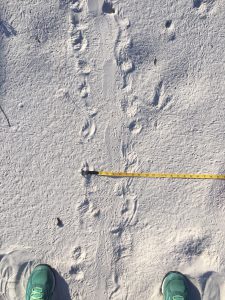
Photo: Cindy Marvel
I interviewed several ole gill netters to see if they remember ever capturing them – same response, “I never heard of those”. I did show one gill netter a photo and he responded – “you know, I think we did catch a couple of these”. But no confirmation of their existence here. It was time to begin searching ourselves.
The team began to survey good terrapin habitat and walking potential nesting beaches looking for any evidence. We did not find it. Then one day in 2007 a gentleman working on a construction site responded to one of our “Wanted Posters”. He said he had seen one of our terrapins. After all of the calls that led to other species, I was not so sure – but he convinced me it might be. So, we checked it out. The sign was placed in good habitat and there were potential nesting beaches nearby. We searched… and we found. What we found were nests that had been depredated by raccoons. There were empty eggshells laying around and two dead hatchlings. There were also tracks in the sand. Confirmation… there were terrapins here!
It was now time to take the show on the road and see if terrapins exist in other counties along the panhandle. My wife and I would take part of our summer vacations and camp along the coast searching. We found at least one record of a terrapin in each of the counties between the Alabama state line and Apalachicola River. All of this was presented to the Florida Diamondback Terrapin Working Group of which there are members from the Florida Fish and Wildlife Conservation Commission. Word was out.

Photo: Molly O’Connor
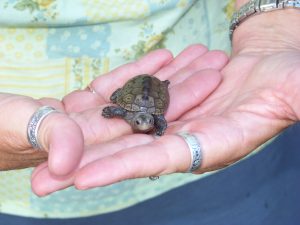
Photo: Molly O’Connor
The next step was to assess their status. How many are here and how are those populations doing?
We did this by following a method developed by Tom Mann with the Mississippi Department of Wildlife. Tom was monitoring terrapins in that state and the subspecies he worked with, the Mississippi Terrapin (Malaclemys terrapin pileata) was the one that was thought to be in Pensacola Bay. So, it was Tom’s method we decided to follow. This includes walking nesting beaches and logging individual tracks and depredated nests in 16-day cycles. Tom’s model assumed that all mature females in the population nest each season and that they do not lay more than one clutch in a 16-day period. The idea is that each track and nest represented one female, and assuming the sex ratio of male to female is 1:1, doubling the number of tracks and depredated nests found in that period would give an idea of how many adult males and females are in this group. Seemed easy enough so these surveys became part of our project.
Another method learned by attending conferences was a 30-minute head count. If you can find the lagoons where the terrapins actually live you can sit and count the number of heads you see in a 30-minute period. It is true that 23 heads does not mean there are 23 terrapins, but the relative abundance can be monitored. If you typically see 20-23 heads and over time that decreases to 11-15, then the relative abundance is declining. It is a method that citizen science volunteers can do and so was included in the project.
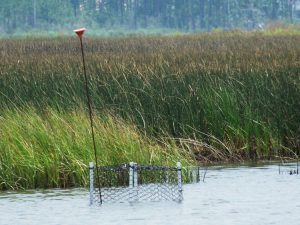
Photo: Molly O’Connor
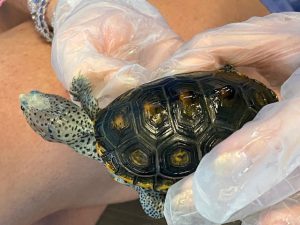
Photo: Rick O’Connor
We also wanted to try and capture individuals to mark and tag. Mark recapture is a method used to estimate populations but capturing terrapins has been historically difficult to do. Several methods have been used by members of the Working Group and we have tried them as well. We have captured terrapins, but very few.
In 2018 the Team partnered with the U.S. Geological Survey to increase the robustness of the project. The Florida Fish and Wildlife Conservation Commission became interested in tissue samples from captured animal to study the genetics of the terrapins in this area. Since 2015 we have trained 228 individuals to conduct surveys, and some have been with me that entire time. Many of them have spent countless hours helping assess the status of this animal in our bays. Many days they see nothing. Others a few tracks or depredated nests. Some locations have good luck with head counts, but many of them finding nothing.
I keep track of “Frequency of Occurrence” (FOO) – the number of surveys where some sort of terrapin encounter happens. This encounter can be as simple as a track in the sand, but they had SOME encounter. It is my hope that over time encounters with them will increase, just as I hope it does with scallops and horseshoe crabs. Since 2007 the FOO has ranged from 12-86% of the surveys conducted, with an average of about 25%. The best year was 2011 (86%), just after the Deepwater Horizon spill. There was a steady increase in FOO from 2007 to 2012 when it took a significant drop. However, this is not because the relative abundance of terrapins suddenly dropped. 2012 was the year I moved from the marine science program at Washington High School to Florida Sea Grant Extension. There were all new volunteers and the learning curve started over. They were not as good at detecting them as the previous group. But that is changing. 2022 is looking to be a busy year for the team.
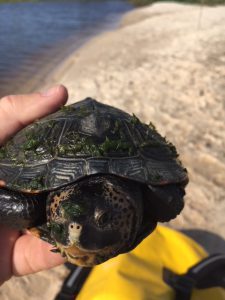
Photo: Rick O’Connor
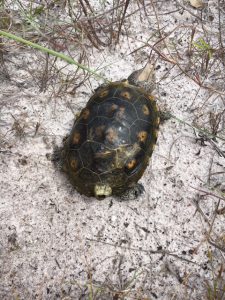
Photo: Rick O’Connor
So far this year we have seen terrapin activity on almost every nesting beach between here and Apalachicola. One site had 49 heads in a 30-minute head count! There have been several active nests, numerous tracks, and plenty of depredated nests. In addition, we have found one dead hatchling and captured two adults. Tissue from these have been collected for the genetic study. But the strangest story this year… a security guard has told us of terrapin hatchlings that have been dropped on their guard shack by birds. Sea birds are known to do this to try and crack open shells of mollusk so they can feed on them. I have never heard of this with terrapins, not here or anywhere.
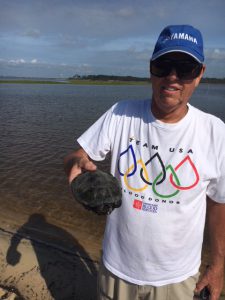
Photo: Rick O’Connor
It seems it is going to be a terrific year for the terrapin project this year. It is exciting for our volunteers to have so many encounters and nice to know that the public is becoming more familiar with this animal. I cannot say whether the population is increasing or not but our knowledge, understanding, and encounters are.
 0
0
